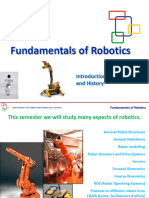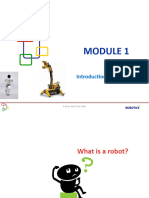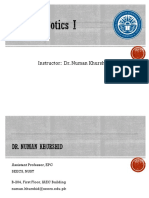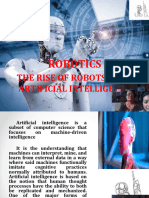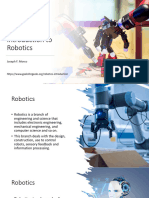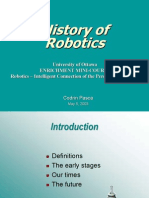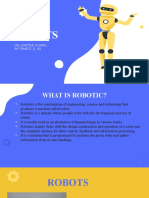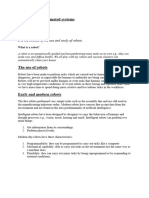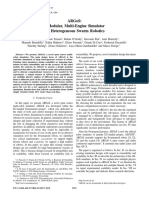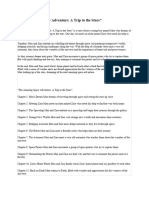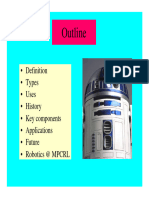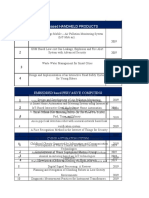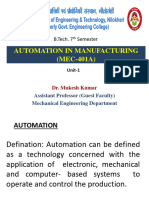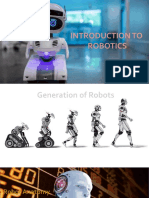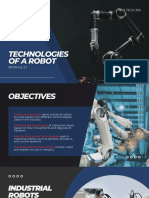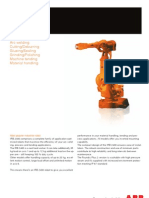Define what a robot is.
Trace the history of robots.
Discuss the persons involved in the history of robots.
Today, some of the most in demand and repetitive jobs in manufacturing are done by robots.
Robots are used in inaccessible places such as exploring our solar system or the bottom of the
sea. Robots also appear in entertainment, research, medicine, and education. Mankind is only
beginning to see the use and value of robotics. With a great emphasis being placed on science,
technology, engineering, and mathematics in our education system, Robotics play an important
part in motivating and exciting students about these subjects.
The following questions deal with the fundamental concepts and principles of this module:
• Why does Robotics play an important part in education?
• How does the evolution of robots affect our everyday lives?
–
�The word are refer to both physical robots and virtual software agents, but it
is usually referred to as bots. There is no approbation on which machines qualify as
robots, but there is general agreement among experts and the public that robots • Why does Robotics play
used to do some or all of the following: move around; operate a mechanical limb; an important part in
sense and manipulate their environment; and exhibit intelligent behaviour, especially education?
behaviour which mimics humans or other animals. • How does the evolution
of robots affect our
everyday lives?
, an American
physicist, engineer, and businessman, was
responsible for the birth of one the most
important and impactful industries, gaining
him global recognition as the
In 1956, Engelberger met American engineer
and inventor George C. Devol at a cocktail party
where the two discussed the writer Isaac Asimov’s
robot philosophies and Devol’s patent-pending
Programmed Article Transfer device. Engelberger https://www.automate.org/a3-content/joseph-engelberger-about
identified the device as a robot, the first ever, and
conceived of how it could be used in manufacturing,
in particular to perform jobs dangerous to humans.
Forging an historic partnership, Engelberger began work with Devol to get his robotic
device developed. In 1957 Engelberger convinced Norman Schafler, CEO of Condec
Corp., the parent company of Consolidated Controls, a firm founded and directed by
Engelberger, to finance the development of Devol’s invention.
• Ctesibus was an ancient Greek engineer who made organs and water
clocks with movable figures.
• “Frankenstein” was about a frightening artificial life form created by Dr.
Frankenstein and wrote by Mary Shelley.
• “Robot” was first used in a play called
by the Czech writer Karel Capek. The plot was simple: man makes
Robot then robot kills man
–
�• Isaac Asimov first used the word to describe the technology of robots and predicted the
rise of a powerful robot industry. He was the science fiction writer.
• Asimov wrote which is a story about robots which contained the
A robot may not injure a human, or, through inaction, allow a human being to
come to harm.
A robot must obey the orders given to it by human beings except where such
orders conflict with would the First Law.
A robot must protect its own existence as long as such protection does not
conflict with the First or Second.
• The was an influence on artificial intelligence research. It was published by Norbert Wiener.
• George Devol and Joseph Engelberger was formed the world’s first robot company in Ewing Township,
New Jersey.
• The computer-assisted manufacturing was demonstrated at the Servomechanisms Lab at Massachusetts
Institute of Technology (MIT)
• Another first industrial robot was activated on the assembly line in a General Motors automobile factory in
New Jersey. It was called
https://shvachko.net/?p=1342&lang=en
• The different researchers at Rancho Los Amigos Hospital in Downey, California discovered
the first artificial robotic arm to be controlled by a computer. It was designed by Rancho Arm as
a tool for the handicapped and its six joints gave it the flexibility of a human arm.
• The first expert system or program designed to execute the accumulated knowledge of subject
experts were Dendral. It was done at Stanford University by Edward Feigenbaum, Bruce Buchanan,
Joshua Lederberg, and Carl Djerassi, along with a team of highly creative research associates and students.
• Marvin Minsky developed the .
–
�• Another invention was the first electrically-powered, computer-controlled robot arm which is the
“Standford Arm” and was developed by Victor Scheinman at Stanford University in California.
• The first mobile robot controlled by artificial intelligence was called . It was produced by
Stanford Research Institute (SRI) International.
The subject
research
from 1966 to 1972, Shakey could
perform tasks that required
The robot greatly
influenced modern robotics and AI
techniques; today, it resides in the
Computer History Museum.
https://www.sri.com/hoi/shakey-the-robot/
• A that performed small-parts assembly using feedback from
touch and pressure sensors was designed by David Silver from MIT.
• The , was discovered by Hans Moravec from Standford University. The cart had a
television camera that took picture from different angles which relayed to the computer. Rapid
advances are being made in robotic control mounted on a rail which took systems, artificial
intelligence, neural networks, and in the pictures from multiple angles and miniaturization,
sophistication, and reliability of electronics.
https://www.computerhistory.org/timeline/ai-robotics/
have helped to boost productivity, safety, and time savings. Robots are able to produce
incredibly accurate, consistent, and high-quality work without needing breaks or holidays off. Industrial robots
also help to remove workers from the hazardous environments and back breaking labor.
–
�Now that you have learned the history of robots try to check your understanding with the following activity.
Directions: Identify the term being described in the statement. Write your answer on the space provided
before the number.
Who discovered the first robot?
What kind of robot was developed by Marvin Minsky?
When was the first industrial robot activated?
Who introduced the first mobile robot?
What was the first electrically-powered, computer-controlled robot?
Who wrote the three laws of robotics?
On what year does the word robotics first used?
Who published cybernetics?
What do you call the first industrial robot activated in New Jersey?
Who helped to boost productivity, safety, and time savings?
Directions: Below are the questions according to the of creating a robot. Please respond
fully to the following questions.
What does it look like?
What materials would you need to make it?
What can it do?
How much would it cost?
Who could benefit from your creation?
Basics of FIRST Robotics - FRC Stuttgart. (2020). Retrieved 23 July 2020, from
https://sites.google.com/a/isswiki.de/frc-stuttgart/basics-of-first
Guevarra, Leah R. “Technology 7: Exploratory (Robotics)”. Batangas State University Main Campus I
Robotics: A Brief History. (2021). Retrieved 28 July 2021, from
https://cs.stanford.edu/people/eroberts/courses/soco/projects/1998-99/robotics/history.html
Robot | Definition, History, Uses, Types, & Facts. (2021). Retrieved 30 July 2021, from
https://www.britannica.com/technology/robot-technology
–
�https://www.automate.org/a3-content/joseph-engelberger-about
https://shvachko.net/?p=1342&lang=en
https://www.sri.com/hoi/shakey-the-robot/
https://www.computerhistory.org/timeline/ai-robotics/
Mr. Jefrey C. Menodza
Mrs. Leah R. Guevarra
Mr. Jefrey C. Menodza
Miss Timmy Anne A. Lopez
George Devol and Joseph Engelberger Asimov
Octopus-like Tentacle Arm 1921
1961 Norbert Wiener
Shakey Unimate
Standford Arm Industrial Robot



